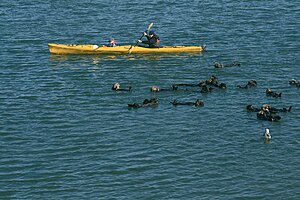
Back كياك Arabic Kayak AST Kayak Azerbaijani Каяк Bulgarian Caiac Catalan Kajak Czech Kajak Danish Kajak German Kajako Esperanto Kayak Spanish

A kayak is a small, narrow human-powered watercraft typically propelled by means of a long, double-bladed paddle. The word kayak originates from the Greenlandic word qajaq (IPA: [qajɑq]).
In British English, the kayak is considered to be a kind of canoe. While technically understandable, in the North American sense this is not the case.
The traditional kayak has an enclosed deck and one or more cockpits, each seating one occupant or kayaker. The cockpit is sometimes covered by a spray deck that prevents unwanted entry of water from waves or splashes, differentiating the craft from an open-deck canoe. The spray deck makes it possible for suitably skilled kayakers to roll the kayak, i.e. to temporarily capsize and submerge the kayak without it filling with water or ejecting the paddler.


Some modern paddlecrafts vary considerably from a traditional kayak design but still claim the title "kayak", for instance in eliminating the cockpit by seating the paddler on top of a canoe-like open deck (i.e. "sit-on-top" kayaks); having inflated air chambers surrounding the craft; replacing the single hull with twin hulls; and replacing handheld paddles with other human-powered propulsion methods such as pedal-driven propeller and "flippers". Some kayaks are also fitted with external source of propulsion, such as a battery-powered electric motor (to drive the propeller/flippers), a sail (which essentially modifies it into a sailboat), or even a completely independent gasoline outboard engine (which converts it into a de facto motorboat).

The kayak was first used by the indigenous Aleut, Inuit, Yupik and possibly Ainu people[1] hunters in subarctic regions of the world.

- ^ There is scant evidence of Ainu peoples using the classic kayak design in prehistoric times. The following indicates that they did use skin-covered vessels, however: "Like the yara chisei, bark houses, ... yara chip, bark boats, were probably substitutes for the skin-covered boat, elsewhere surviving in the coracle and kayak. Skin-covered boats ... are referred to in old [Ainu] traditions. -Ainu material culture from the notes of N. G. Munro: in the archive of the Royal Anthropological Institute, British Museum, Department of Ethnography, 1994, p. 33
© MMXXIII Rich X Search. We shall prevail. All rights reserved. Rich X Search